Samsung Galaxy S 4 Review - Part 1
by Brian Klug on April 24, 2013 12:01 AM ESTBattery Life and Charge Time
The Galaxy S 4 features a removable 9.88Wh battery with 3.8V chemistry. The battery design is par for the course for any high end smartphone, but the fact that it's removable remains a staple of the Galaxy S design. Whether or not the bulk of consumers actually use the flexiblity offered by a removable battery is up for debate, but there's no doubt about the fact that Samsung has a strong following of users who appreciate the feature.
Unfortunately, only having access to the Sprint version of the Galaxy S 4 to review, most of our battery life tests on the cellular network aren't all that useful. The good news is that our WiFi tests should at least give you an idea of how well the SGS4 will compare to the HTC One when both are on the same network. We're using the latest revision of our smartphone battery life test to compare performance of all the key players here. This is now our sixth revision of the battery life test, and we feel is the optimal balance between challenging workloads and idle time. The basic overview is the same as the previous test — we load webpages at a fixed interval until the handset dies, with display set at exactly 200 nits as always. Power saving features are disabled if they turn on automatically, and background account sync is disabled. The test is performed over both cellular data on all available air interfaces and over WiFi in an environment with good signal levels. The new test has decreased pause time between web page loads and added a number of JavaScript-heavy pages. I sat down with some UMTS RRC (Radio Resource Control) emulator tools and also made sure we had a good balance of all the RRC states (DCH, PCH if possible, FACH, IDLE) so we weren’t heavily biased towards one mode or the other.
As the most relevant comparison of platforms we have today, we'll start with the WiFi version of our web browsing test:
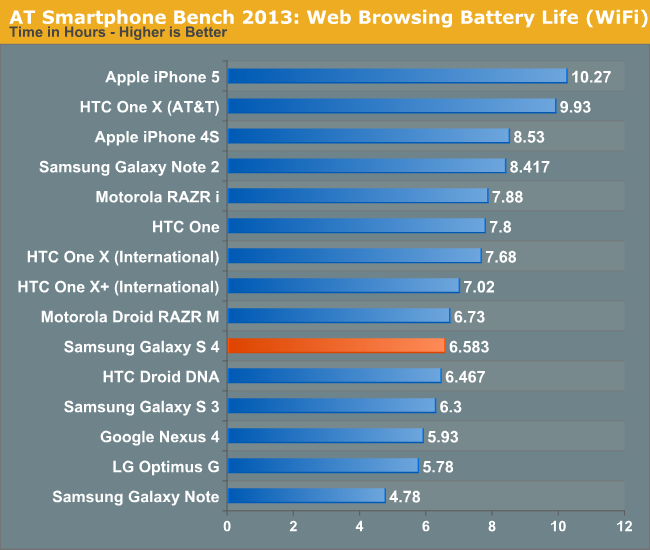
On WiFi the Galaxy S 4 falls behind the HTC One by an appreciable amount, however there's still an improvement in battery life compared to the Galaxy S 3. The Galaxy S 4's battery life isn't bad by any means, but do keep in mind that this is a large phone with a large display and a very powerful SoC. For much of the past year we've been talking about an increase in dynamic range in total platform power of high end smartphones and the Galaxy S 4 is no exception. Run it at full brightness or keep many cores running in their maximum performance states for a considerable period of time and you'll be greeted by a phone that's quickly in need of a power outlet.
As I mentioned earlier, we only have access to the Sprint version of the Galaxy S 4 at this point which unfortunately means that our 3G results aren't all that comparable to other devices here.

Even on Sprint, the Galaxy S 4 does surprisingly well.
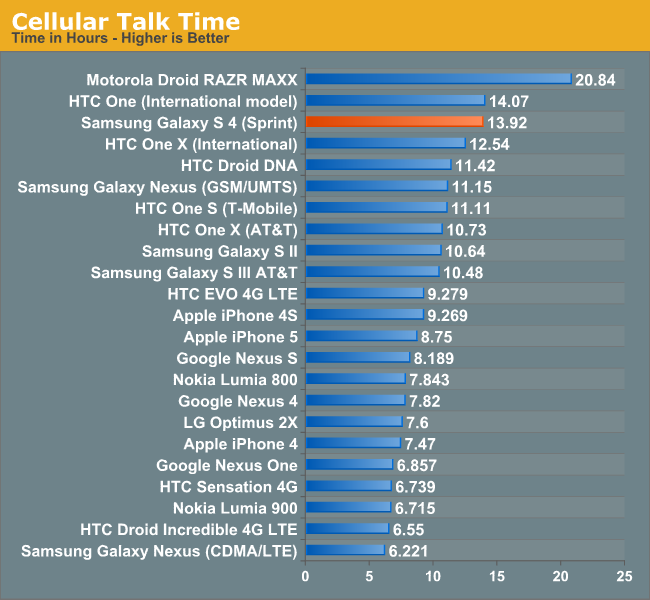
Talk time is excellent on the Galaxy S 4, with the phone delivering effectively the same battery life as the HTC One. Without having to power on that huge display, the Galaxy S 4 can last for a very long time on a single charge.
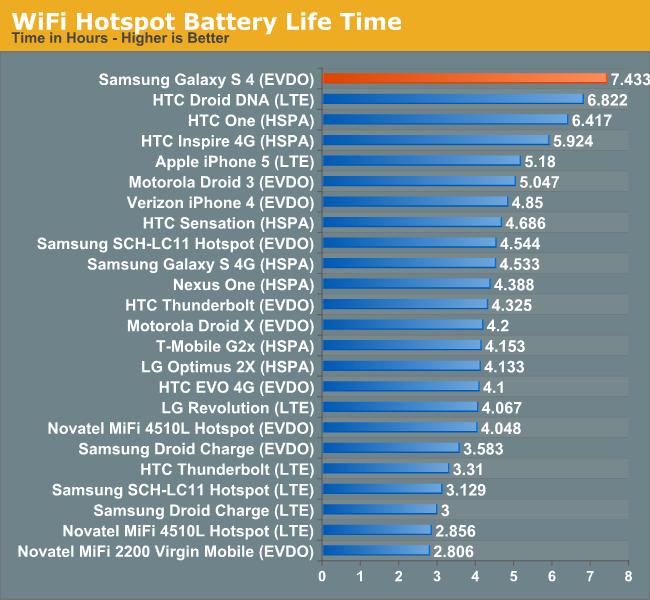
A combination of the Sprint network and the fact that the Galaxy S 4's display remains off during our hotspot test resulted in great battery life here as well. Again, this data isn't all that useful if you're not on Sprint but Samsung tells us we should be able to get our hands on an AT&T SGS4 in the not too distant future.
Charge Time
Samsung appears to implement Qualcomm's Quick Charge specification in the Galaxy S 4 and its bundled charger. I realize we haven't done a deep dive into what Quick Charge is and how it works, but I'll try to go through a quick explanation here. Most conventional chargers are linear, they take a fixed amount of input current (at 5V) and pass it along to the device being charged. The problem is that at deeply discharged states, the device's battery might be at a substantially lower voltage. A traditional linear charger won't change the current supplied based on the voltage of the battery being charged, and as a result can deliver sub-optimal charge times. When implemented, Qualcomm's Quick Charge technology can vary output current based on the voltage of the battery being charged, which results in less power being dissipated as heat and more being delivered to charging the battery itself. The table below helps illustrate the savings:
Quick Charge, at least in its currently available 1.0 specification, is still bound by the 5V limits of the USB BC 1.2 specification. The next revision of Quick Charge will enable higher voltage operation for even faster charge times.
| Qualcomm Quick Charge 1.0, Theoretical Example | ||||||
| Input Current @ Voltage | Input Power | Output Current @ Discharged Battery Voltage | Output Power | |||
| USB BC 1.2 - Linear Charger | 475mA @ 5V | 2.375W | 475mA @ 3V | 1.425W | ||
| Qualcomm Quick Charge 1.0 | 475mA @ 5V | 2.375W | 700mA @ 3V | 2.100W | ||
The non-linear nature of Quick Charge significantly shortens charge time, particularly in the very early stages of charging when the device's battery is presumably fully discharged. As the device's battery voltage increases, current delivery tapers off and the QC advantage is no longer as great as a standard USB BC 1.2 solution. The end result though is significantly improved charge times.
The graph below shows the benefits of using Samsung's own charger vs. a standard charger that implements the USB BC 1.2 specification. When used with the bundled charger, the Galaxy S 4 recharges much faster than HTC's One, despite using a larger battery. Obviously the Galaxy S 4 will charge with any USB charger, but the charge time will simply be longer. Samsung uses a voltage divider and signals the presence of their own charger by sending 1.2-1.3 V across the D+ / D- pins, this is similar to what Apple does with 2.0 or 2.8 V across the pins for various USB chargers they've shipped over the years. This signaling is essentially Samsung's proprietary tablet charging signaling which they've employed on the Galaxy Note 2 and now SGS4, in fact the two use the same exact charger, so it's worth tossing out your old ones and getting the appropriate one to take advantage of the faster charging.
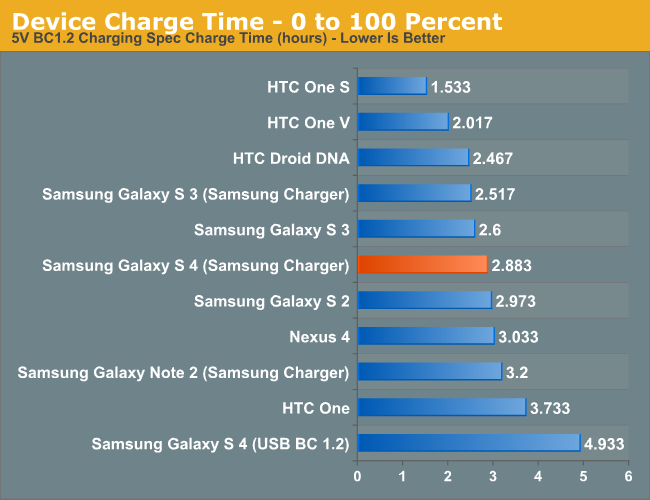


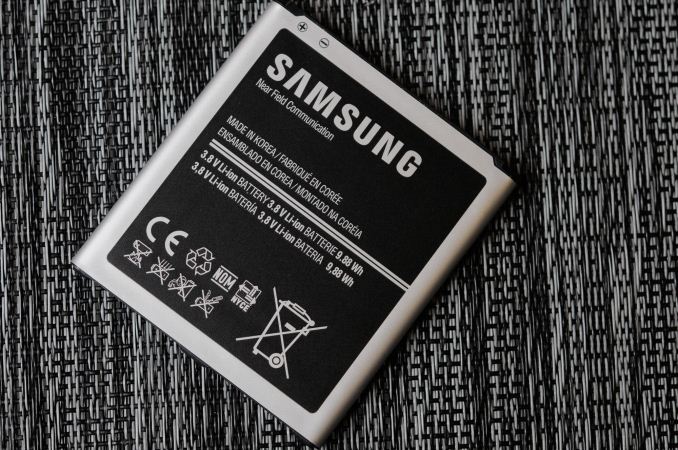








335 Comments
View All Comments
CoryS - Friday, April 26, 2013 - link
Eh, I actually think phones are getting too thin. I put a case on my GS3 because I kept fumbling it due to how thin it was.nerdstalker - Wednesday, April 24, 2013 - link
What's with the QUALCOMM 4G sticker on the top bezel of the device? :sHaserath - Wednesday, April 24, 2013 - link
They're using a Qualcomm Snapdragon SOC with integrated LTE (4g)modem, I believe.nerdstalker - Wednesday, April 24, 2013 - link
Going the Intel way. :PBrian Klug - Wednesday, April 24, 2013 - link
There's been a Qualcomm 4G sticker on the top of Samsung phones since, hmm, T-Mobile SGS2 and AT&T SGS2 (Skyrocket). Even the Droid Charge/Galaxy Nexus VZW edition which had no Qualcomm parts inside did, ostensibly due to some part of the OFDMA/LTE stack being licensed for CMC221, but that was never made clear.-Brian
nerdstalker - Wednesday, April 24, 2013 - link
Interesting. Thank you for the info.ranblv - Wednesday, April 24, 2013 - link
Idon't care about removal battery, I do however care about expandable storage. carrying an extra 32GB micro sd card in my wallet saved the day many times when I needed to shoot video or transfer docs.Great review, I don't always care that much for the minor details but I like it that someone like you is making sure they deliver what they say they do.
janosch.from.afar - Wednesday, April 24, 2013 - link
cannot understand why HTC cant simply add a tray to its smartphone side to insert a battery and sd card. Much like the iphones do it with their sim card tray.Besides, samsung could simply allow two sdcard slots, instead of one - but they should try to improve the SdExtcard mount first, so to being able install all software to it.
UpSpin - Wednesday, April 24, 2013 - link
It adds further parts to the bill list, makes the frame less sturdy because you have to drill a huge hole in the side, you have to add some mechanism to lock it and you have to route all wires on the opposite side, because the battery tray side gets lost for antenna, wires, parts. With plastic it's easy because you can bent the back and remove the whole back, with aluminum it's more difficult, you have to use screws.But I agree, it's still possible. For example they could have used some screws to attach the back. It might have looked even better with screws than without them, but easy swapping won't be possible, so it has little use at all and few people really take advantage of battery swapping, so they probably just risked it with a fixed battery.
And a sd-card could have fitted easily, just as you can exchange the sim card. But here again, it's important for some (I would like one, too), but the majority gets confused with a second storage which is more likely to fail and which can't get used like the internal one, and few understand this.
holyanan - Wednesday, April 24, 2013 - link
I have to say that the browsing time is really disappointing, i fail to understand why iphones provide with supposedly twice as much browsing time - which is one of the primary functions of a phone nowdays.